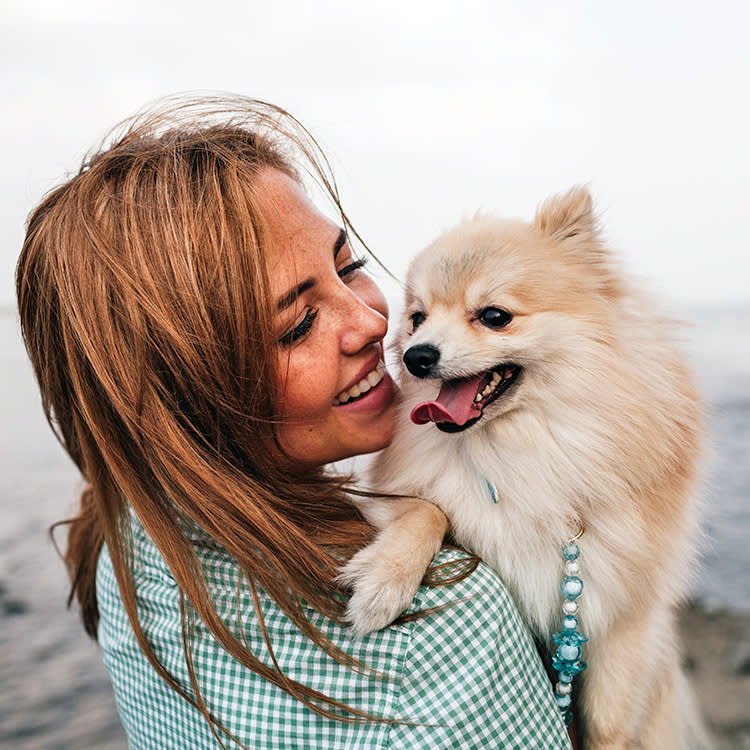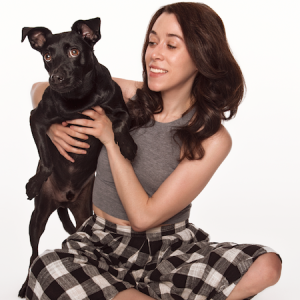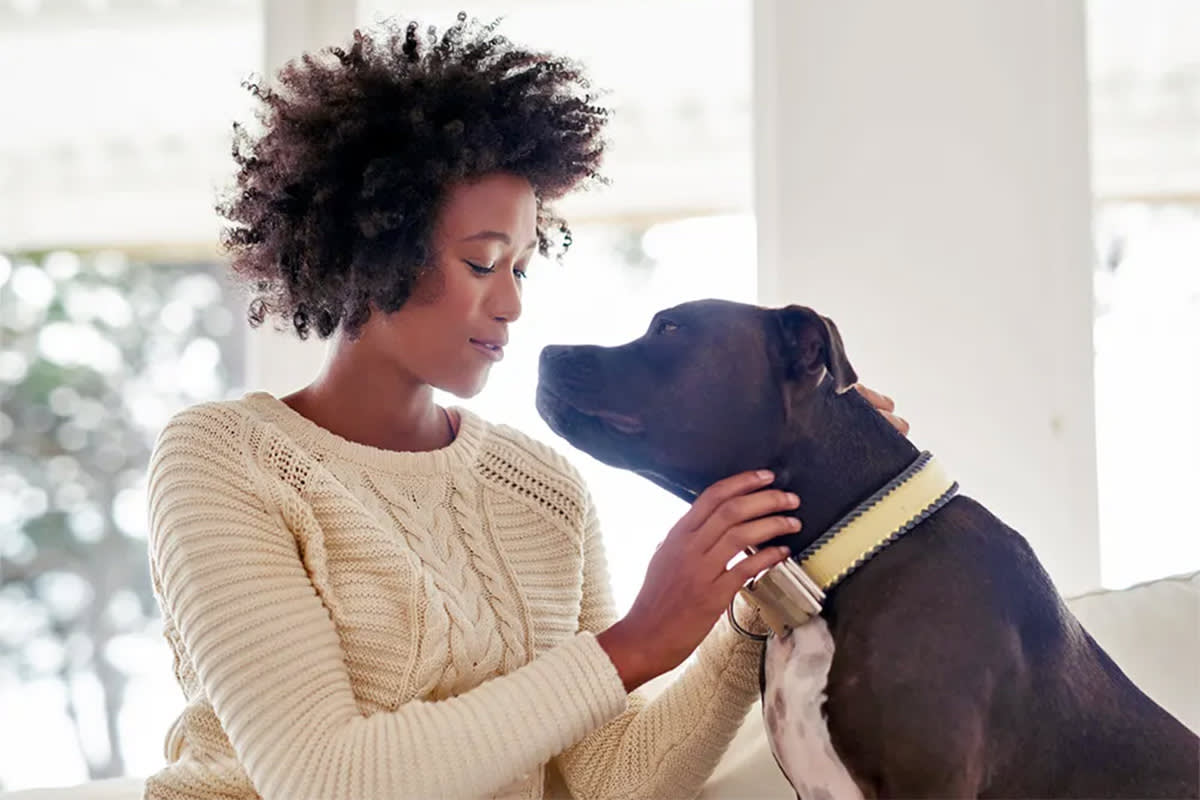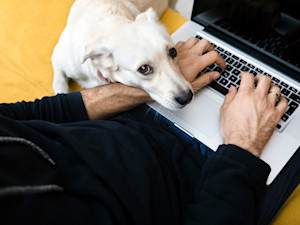People and Their Dogs Really Do Have Similar Personalities, Research Finds
Is your pup mirroring your emotions?

Share Article
My dog and I are a lot alike. We’re both shy and a little guarded; we don’t like crowds or unplanned interactions with strangers. We love lounging around and having treats. It can feel like like we’re vibrational twins or soulmates, responding to the world in the same ways — but is that projection on my part?
It turns out it might not be, at least not fully. (Though he may not enjoy watching Real Housewives as much as I like to think he does.) Dogs can mirror their guardians’ personalities in subtle but meaningful ways. Confident pet parents can end up with outgoing dogs, while anxious or highly sensitive people can have dogs who seem a little on edge. But this isn’t emotional osmosis. Dogs are keen observers, and they’re tuned in to our tone, our body language, and the routines we create. Over time, they adjust to us, shaping an expression of personality that feels remarkably familiar.
Still, even when dogs pick up on our moods or reflect our personalities, it isn’t the same thing as experiencing our emotions exactly (especially when it comes to things like guilt, which dogs don’t actually experienceopens in new tab). They’re living in our world, reading the cues we provide, and learning what responses work in relationship with us. So, how much of a dog’s personality is a reflection of our relationship with them?
Genetics, environment, and human behavior all shape a dog’s personalty.
Let’s start with what shapes a dog’s personality in general. When it comes to a dog’s temperament, genetics matter, but they’re only the starting point.

“Genetics sets a baseline, but does not write the whole story,” says Dr. Eliza O’Callaghan, managing veterinarian at Small Door Vet in New York City. A large genomic study of thousands of companion dogsopens in new tab recently found that while many behavioral traits are heritable, breed alone explained only about nine percent of the differences in behavior among individual dogs. In other words, knowing a dog’s breed might tell you something about general tendencies, like trainability, but it won’t tell you whether your specific dog will be, for example, shy or confident.
Environment has just as much of a say. Studies showopens in new tab that puppies raised with positive experiences during the so-called socialization window,opens in new tab between three and 12 weeks old, tend to grow into calmer, more adaptable adults, while limited or negative exposure during that period is linked with greater fearfulness down the line. And how dogs live beyond puppyhood continues to shape their behavior. Surveys have shown opens in new tab that dogs who don’t consistently have their exercise and mental stimulation needs met are more likely to show social fearfulness and other behavioral challenges.
And then there’s our impact. Studies that measure opens in new tab both dog and guardian personalities opens in new tab have found that human traits can influence canine behavior. In some research, guardians with higher levels of anxietyopens in new tab or neuroticism were more likely to have dogs who displayed aggression or stress behaviors. “These are correlations, not destiny,” Dr. O’Callaghan says, “but they suggest that handling style, predictability, and stress management on the human side are meaningful levers.”
Dogs genuinely respond to our emotions, but we can sometimes mistake what they’re communicating.
Anyone whose dog has ever snuggled up next to them during a tough moment or seemingly comforted them when they were sick, has probably wondered whether they were really watching their dog empathize, or if they were projecting.
“The first question to ask is whether your dog’s behavior changes in real time with your emotion, or whether you’re labeling a look after the fact,” Dr. O’Callaghan says. Dogs are remarkably good at reading our tone, posture, and expressions, a phenomenon researchers call social referencing. (We’re, sadly, less good at reading theirs.) In one experimentopens in new tab, dogs were more likely to approach a new object when a person looked positive while standing beside it; when the person looked worried, the dog hung back. “That is genuine, context-appropriate ‘reflection,’” Dr. O’Callaghan says, “not projection.”
This sensitivity extends beyond the visual. Brain imaging shows that dogs have dedicated voice-sensitive regions opens in new tab and can tell the difference between neutral, happy, and angry tones. They don’t just hear our words; they hear the emotions behind them.
We can can even sync up with our dogs biologically. In one study, when guardians spent time and experienced emotional closeness with their dogs, they and their dogs’ heart-rate variability shifted in tandem. It’s evidence that our emotional state can influence theirs in measurable ways, beyond behavior alone.
Dr. O’Callaghan warns, though, against reading too much into a dog’s expression. The infamous “guilty look,”opens in new tab for instance, doesn’t actually mean guilt at all. In controlled tests, dogs made the same face whether or not they’d actually done something wrong; what mattered, instead, was whether their pet parent thought they had, and how they treated the dog as a result. “The behavior is best understood as appeasement to our cues, not moral guilt,” Dr. O’Callaghan says. “This is the classic case of human projection.”
Dr. O’Callaghan offered two scenarios to understand the difference between reflection and projection. In the first, your mood shifts, your voice softens, your shoulders drop, and your dog relaxes, approaches, or explores the surrounding environment after checking in with you.
“That is social referencing and vocal-emotion sensitivity at work,” she says. In the second, you come home to a mess. Once you react to the sight of it, your dog shows lip-licking, head turns, or crouching. “Those are appeasement signals to your behavior,” she says, “not proof the dog ‘feels guilty.’”
Dogs can mirror their guardians’ temperament through shared routines and emotional environments.
“There is real, but modest, evidence that owner and dog traits align,” Dr. O’Callaghan says. “Mostly through shared environment, routines, and handling rather than simple emotional contagion.”
In one studyopens in new tab, researchers measured stress hormones in the hair of dogs and their guardians across different seasons and found that the levels rose and fell together. The findings suggest that long-term stress in humans can subtly shape a dog’s baseline arousal. Short-term coupling happens, too: in lab settingsopens in new tab, a calm or anxious guardian can influence their dog’s heart-rate patterns.
Behavioral data tell a similar story. Surveys of thousands of dog–guardian pairs show that pet parents who describe themselves as calm and consistent tend to have more sociable, resilient dogs, while those who report higher emotional instabilityopens in new tab often have dogs that show more fear-based or reactive behavior. “These are correlations, not destiny,” Dr. O’Callaghan says. “But they reinforce the practical takeaway: calm, predictable routines and reward-based handling by the human tend to produce steadier dogs.”
Dogs are great at picking up on our tone, posture, and cues, but consistency matters more than words.
Brain imaging has shown that dogs process what we say and how we say it in different areas of the brain, then integrate the two. That’s why a cheerful tone with clear words works better than mixed signals. Dogs are also skilled at following human gaze and gestures, showing that they’re attuned to consistent patterns in our body language rather than individual movements. “Dogs read patterns and contingencies,” Dr. O’Callaghan says, “not minds.”
The flip side is that inconsistency can confuse them. Dr. O’Callaghan notes that mixed or inconsistent signals and reinforcement “create confusion and slower learning.” To reliably be on the same page with your pup, use consistent cues, predictable routines, reliable positive reinforcement, and clear emotional messages.

Kelly Conaboy
Kelly Conaboy is a writer and author whose work has been featured in New York Magazine, The New York Times, and The Atlantic. Her first book, The Particulars of Peter, is about her very particular dog, Peter. (Peter works primarily as a poet.)
Related articles
![A woman sitting on a floor playing with her dogs.]()
How to Know if Your Dog Has Imprinted on You
If they’re following you around like your shadow, there’s a reason for that.
Should You “Gentle Parent” Your Dog?
If it’s good for kids, it’s probably good for dogs, too.
Does Your Dog Get Sad When You’re Sad?
They can tell when you’re in a state of ennui. Learn if that bums them out.
Can Pets Experience Trauma After a Scary Event?
Your guide to understanding PTSD in pets—including how to help them heal.
Is My Dog Self-Aware? How to Measure Their Levels of Awareness
They notice more than you think.
![dog looking up at person on laptop]()
Yes, Your Stress Is Making Your Dog Stressed, New Study Finds
It might be time to take a deep breath for both of your sake.







